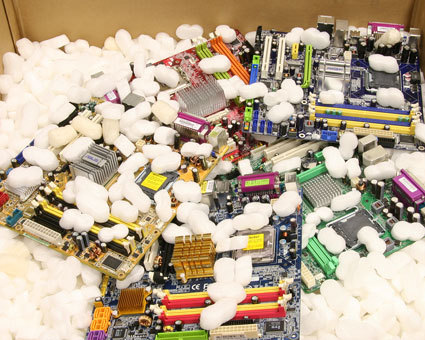Four MicroATX Mobos for Core 2
Four MicroATX Motherboards For Your Compact Core 2 Duo System
If you browse etailers' offerings you will probably find at least 20-30 different motherboards that can accommodate your processor. But which is the best product?
There are differences when it comes to features and interfaces, overclocking potential and capabilities such as monitoring options or automated software updates via the Internet. First and foremost you should find out whether you want a classic, full-size ATX motherboard or a compact MicroATX model. Full-size boards will give you plenty of room for expansions while MicroATX saves space and cost, and is more likely to fit into sleek and stylish design cases. The latter is an important quality if you want to assemble a family-friendly system for your living room.
Performance-wise, there is no difference between the different form factors, whether it's a full-size ATX, MicroATX, BTX, MiniITX or other less common standards. Using the same core logic, a MicroATX motherboard can deliver the same basic features and performance as a full-size ATX board. Yet MicroATX boards are often stripped-down, as they have to meet aggressive price points. This is because MicroATX is the dominating form factor for business computers, which are typically sold in large quantities and competition in this area is thus fierce.
MicroATX motherboards typically do not use performance chipsets for dual graphics and they won't allow you to install tons of memory and lots of add-in cards. The core logic usually features integrated graphics, using parts of your main memory to store graphics and video data. This won't get you anywhere if you want to run 3D applications or 3D games because integrated solutions are very much underpowered for 3D performance. But integrated graphics is certainly adequate for multimedia, office applications, basic content creation or anything that doesn't require a lot of 3D power. Lastly, having an integrated graphics subsystem is the key to creating low-power computers, because this approach does not consume the 30 to 150 W of discrete graphics cards for AGP or PCI Express.
So if you seek a platform to power your new office or multimedia PC, the four MicroATX contenders we review from Asus, Foxconn, Gigabyte and MSI are worth a look. They come with all the necessary features including Serial ATA connectivity for the latest hard drives, integrated Gigabit Ethernet networking connectivity, average sound systems, at least two 32 bit PCI slots for expansion cards and sufficient USB 2.0 ports for external storage devices, mice, keyboard, a webcam, printers or other peripherals.
Not sure about the integrated graphics? All the boards offer an x16 PCI Express slot, which will accommodate any new 3D graphics card - should you decide that you cannot live without decent 3D performance.
Join our discussion on this topic
Get Tom's Hardware's best news and in-depth reviews, straight to your inbox.
Current page: Four MicroATX Motherboards For Your Compact Core 2 Duo System
Next Page Chipset No-Choice: G965 Or G965?
Patrick Schmid was the editor-in-chief for Tom's Hardware from 2005 to 2006. He wrote numerous articles on a wide range of hardware topics, including storage, CPUs, and system builds.
